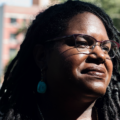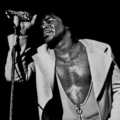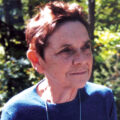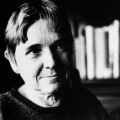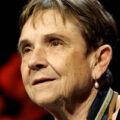Witness: #BlackLivesMatter, Claudia Rankine, and Adrienne Rich

Catch if you can your country’s moment, begin
where any calendar’s ripped-off—Adrienne Rich, “An Atlas of the Difficult World”
In thinking about how Adrienne Rich speaks to our present struggles for civil rights and justice, I was drawn to a poem of witness, one that testifies to a scene of state violence against black Americans from a time before such attacks could be captured with a phone camera and given viral exposure. In “Frame” Rich narrates an incident that took place at Boston University in 1979, in which a black female student, taking shelter in a building while waiting for a bus, was arrested by police for trespassing and brutally beaten in the process. Official silence and erasure is the frame around the incident—“I can hear nothing because I am not supposed to be / present”—which Rich disassembles through the repetition of “silence” and by claiming a first-person, witnessing presence in the scene:
in silence that they throw her into the cell
in silence that she stares him
straight in the face in silence that he sprays her
in her eyes with Mace in silence that she sinks her teeth
into his hand in silence that she is charged
with trespass assault and battery in
silence that at the sleet-swept corner her bus
passes without stopping and goes on
in silence. What I am telling you
is told by a white woman who they will say
was never there. I say I am there.
Rich’s powerful assertion of presence in this poem was what drew me into a lifelong interest in how her work acts as a witness, or series of witnesses, to the places and communities excluded from official American history. Her works conjures up a political and historical collective that Stephen Burt calls an “alert, untidy, unfinished, and international coalition.”
Rich’s injunction to catch our country’s moment precisely where it is ripped from official accounting of time and history is especially relevant now. In the wake of recent killings of unarmed black Americans—including but not limited to Trayvon Martin, Michael Brown, and Eric Garner—protest movements have risen up against a legal and social system that, by finding no grounds to prosecute their murderers, effectively removes these events and the fact of slain bodies from any officially actionable American history. The resistance to this erasure has come from many directions, but has found a common reference point in #BlackLivesMatter: a protest movement, social media meme, and cultural affirmation of black life founded by three black, queer women.
Read as a kind of kin or precursor to the movement’s evolution of protest and artistic testimony, Rich’s choices as she navigated her own American times help illuminate how the broader Black Lives Matter moment relates to the arts of past liberation efforts. As Rich sought to address the lives of people of color as part of the “coalition” that she felt compelled to represent in her work, she attempted to act as a witness to iconic examples of state violence against black people, grounded in deliberately historicized places. In considering Rich’s witnessing persona, I hope to bring into further relief the identities that #BlackLivesMatter activists, as well as established poets like Claudia Rankine, create in order to counteract the contemporary American erasure of black lives.
The activist founders of the Black Lives Matter movement—Patrisse Cullors, Alicia Garza, and Opal Tometi—came together in the wake of Trayvon Martin’s murder in 2012. With the killing of Michael Brown in August 2014 by police in Ferguson, Missouri, #BlackLivesMatter became known as a virtual meeting-place and symbol of protests taking place across the country. Even as they have sought to “curate” the movement, in Cullors’ words, their definitional statement faces pressure both from within and outside progressive groups. Cullors says in one interview, “well-intentioned groups tried to adapt the message—Brown Lives Matter, All Lives Matter—in ways that frustrated the three women, who had worked hard to convince the black community ‘to name blackness as part of a broader conversation about racialized violence’.” In Garza’s words, this crucial act of naming goes beyond blackness to encompass other intersecting groups who must get free in order for everyone to be free: “Black Lives Matter affirms the lives of Black queer and trans folks, disabled folks, Black-undocumented folks, folks with records, women and all Black lives along the gender spectrum. It centers those that have been marginalized within Black liberation movements.”
Likewise, Rich’s career from the 1970s onward traced a similar path, seeking to re-frame the feminist movement in order to recognize lesbian existence, while finding her words “becom[ing] responsible / for more than we intended,” as she wrote in “North American Time.” In essays such as “Compulsory Heterosexuality and Lesbian Existence,” Rich insists that feminists need to recognize and claim lesbian existence in order to resist patriarchal society in all its manifestations. Her collaboration during this period with women of color broadened her activism and poetic sense of witness. Written in 1983, “North American Time” finds Rich working to bring Native Americans, immigrants, Jews, and other groups into dialogue with women and people of color, as part of a broader effort to assert a counter-history of North America. Focusing in on Rich’s use of place here to evoke history and artistic responsibility uncovers an important intersection with the arts of the Black Lives Matter movement.
The signal declaration of “North American Time” is that “poetry never stood a chance / of standing outside history.” This multi-layered metaphor suggests, as Harriet Davidson writes, that the political poet’s decision to take a stand “paradoxically allows change as it opens itself up to chance” given the “mutat[ing]” interaction of words and contexts over time. Rich’s advice to her sisters and poets here prefigures for Black Lives Matter not its current scaling-up struggles, but rather what the movement will look like in five years or decades hence.
Poet, sister: words—
whether we like them or not—
stand in a time of their own.
No use protesting I wrote that
before Kollontai was exiled
Rosa Luxembourg, Malcolm
Anna Mae Aquash, murdered,
before Treblinka, Birkenau,
Hiroshima, before Sharpeville,
Biafra, Bangla Desh, Boston
Atlanta, Soweto, Beirut, Assam
—those faces, names of places
sheared from the almanac
of North American time
This coalition mirrors the internationalization of #BlackLivesMatter while pointing to the need for a struggle, over time, to maintain the urgency of “faces [and] names of places” whose lived histories are effaced from official accounts of American history. Rich speaks of the continual need for one’s words as an artist to remain accountable. Of particular relevance to our moment, she cites vital “places” such as the black feminist organizing effort after the murders of black women in Boston in 1979 and similarly overlooked murders of black children in Atlanta that year. As an activist in the moment and an artist in the fourth decade of her career, Rich looks back at her previous work and sees it lacking, unable to grapple with these new watersheds in the unrecognized American almanac.
Patrisse Cullors’ recent art is rooted both in the immediacy of her Black Lives Matter activism and in her own efforts to create a radical alternative history that contextualizes state violence against black people. During the Fall of 2014, in the midst of tumultuous protests across the nation, Cullors was an artist-in-residence at Kalamazoo College and co-directed a student performance entitled “Power: From the Mouths of the Occupied.” The performance blended narratives of student protests in Ferguson as well as the students’ own descriptions of racist violence they had experienced, with the context of a petition presented to the United Nations in 1951 which charged the US with genocide against its black citizens. Adducing the “We Charge Genocide” petition fits this work’s student-led testimony very much within a counter-history in which black Americans have standing “as patriots” (per the petition text) to bear witness to aspects of American history that are typically unspeakable.

As the curator of this performance, Cullors integrates the protest experiences of Black Lives Matter and the students’ own histories almost in real time. One of the students grounds her immediate reactions to Michael Brown’s death in a way that summons up memorials, another type of American space that Rich has made an eloquent vehicle for alternative lives and histories:
It was so sad when Mike Brown died, but thank God it’s not me. Thank God it’s not here. Thank God I don’t have to walk outside and see memorials. And I realized but wait, that’s not good. I shouldn’t be this comfortable when it’s stuff that’s happening to people just like me.
This passage expresses the ethical obligation of witnessing—a burden which Rich, like this student, found herself enacting in different ways. In particular, the student’s evocation of informal memorials to Mike Brown recalls Rich’s most celebrated poem of her later career, “An Atlas of the Difficult World” (1991), in which she pulls American monuments into the contested zone of “faces, names of places” that are present or not within the nation’s self-understanding.
In “Atlas,” Rich seems to speak from a more far-seeing poetic perch than in “North American Time,” consciously constructing an alternate national geography and poetic canon of her country. Her narrator shows the obligation to witness her country’s violence with a repeated assertion that the artist has no alternative source of inspiration: “I don’t want to know / wreckage, dreck and waste, but these are the materials.” As in “North American Time,” the evocative places where American history is “ripped-off” connect a scene of state violence against black Americans with other key locations of historical violence. Rich creates a figurative landscape in which her overspilling lines echo the uncontainable voices erupting from within the nation’s official monuments:
Catch if you can your country’s moment, begin
where any calendar’s ripped-off: Appomatox
Wounded Knee, Los Alamos, Selma, the last airlift from Saigon
the ex-Army nurse hitch-hiking from the debriefing center; medal of spit on the veteran’s shoulder
—catch if you can this unbound land these states without a cause
earth of despoiled graves and grazing these embittered brooks
these pilgrim ants pouring out from the bronze eyes, ears, nostrils
the mouth of Liberty
over the chained bay waters
San Quentin:
once we lost our way and drove in under the searchlights to the gates
end of visiting hours, women piling into cars
the bleak glare aching over all
Where are we moored? What
are the bindings? What be-
hooves us?
Though the natural setting of this America may be literally and historically poisoned, Rich demonstrates its self-testifying power: a humble crowd of ants occupies the Statue of Liberty, with what may be either peaceful protest or an insistent march over a no-longer relevant boundary. This and other gestures in “Atlas” make the statue into what I once referred to as a “counter-monument,” or “a boundary for disputes to determine which strands of cultural memory are publicly acknowledged.”
Two additional counter-monuments are evoked in this line. The first, explicitly, is the California state prison at San Quentin. The bridge across the country, from Liberty to the prison, is the Brooklyn Bridge, as cited in Hart Crane’s “The Bridge.” In “Atlas” Rich uses images of bridges, roads, and restlessly journeying figures (including herself) to express the country’s physical enjambment (or “binding”) between monument and prison, espoused values and lived injustices. She posits that those who would blindly hold only to the dominant historical narrative embodied by the Statue of Liberty—“trying to revive dead statues to lead us, breathing their breath against marble lips”—recognize the threat posed by unrecognizable people and places insisting on their place in America’s self-conception.
One such new monument is the handmade memorial to Mike Brown on Canfield Drive in Ferguson. Activist Darnell Moore—a leader with Cullors, Garza, and Tometi of the first major #BlackLivesMatter bus caravan to Ferguson—has noted in a panel discussion on police violence just how intimate a setting the narrow street is. He remarked on how that fact magnified the violence of Mike Brown’s killing, and how his lying unaided for hours afterwards impacted all those forced to witness the events.
On Christmas Day 2014, someone drove over the memorial on Canfield and scattered the objects there through the street. Though the memorial was reassembled, the reactions to the meaning of this act illustrate how such counter-monuments exist at a border of different perceptions of human life’s value. When a reporter called the Ferguson police to ask about the memorial, an officer said, “you’re calling me about a pile of trash in the street?” One need only consider the very different treatment given a similar “pile” of humble offerings in Copley Square, after the Boston Marathon bombings, to recognize that a given memorial, and the people or history remembered there, reflect back the physical and metaphorical associations of those who see them in place.
 The cover of Claudia Rankine’s book-length poem Citizen: An American Lyric presents another symbol at the border of what different Americans see: a vacant hood. The hoodie has become shorthand for what some white people see as the threat of the black body, one that justifies murder—the fear of what Officer Darren Wilson described as the “demon” he saw in Mike Brown. The hoodie was taken up after Trayvon Martin’s death as a symbol for those who would identify with him, and what his death represented.
The cover of Claudia Rankine’s book-length poem Citizen: An American Lyric presents another symbol at the border of what different Americans see: a vacant hood. The hoodie has become shorthand for what some white people see as the threat of the black body, one that justifies murder—the fear of what Officer Darren Wilson described as the “demon” he saw in Mike Brown. The hoodie was taken up after Trayvon Martin’s death as a symbol for those who would identify with him, and what his death represented.
Rankine’s poem explores the passing moments of racism she experiences in her otherwise comfortable professor’s life, and how they relate to the racially-invested killings of Trayvon Martin and young black men. Like Rich, Rankine takes the violent terrain of American life as a challenge to the self who attempts to witness her own life and her country. The empty hoodie illustrates twin aspects of selfhood for the person of color in modern America: that she is in a body “always addressable, always within stigma’s reach,” as Rankine described in a discussion with Beth Loffreda on their book The Racial Imaginary: Writers on Race in the Life of the Mind, while she is also challenged to generate a self that can claim subjectivity from within that body and the imposition of multiple socially-enforced identities.
In its survey of racial encounters and subjectivity, the scope of Citizen puts it in dialogue with Rich’s “Atlas.” Each work presents a poet at the height of her powers, reckoning with her country, and seeking to place herself among her fellow citizens. Both Citizen and “Atlas” culminate by engaging readers through each poem’s definition of what it is to be in and of America. In these key moments both Rich and Rankine imagine disparate, sometimes mutually invisible American communities engaged in the work of defining their country. But the differences in who calls these communities into engagement demonstrate the particular challenges of witnessing black lives in America.
The final section of “Atlas,” titled “Dedications,” identifies a wide range of Americans in various states of stress, change, and struggle, all united on the ground Rich defines within the poem itself. “I know you are reading this poem,” the sweeping lines of this section each begin, before evoking Rich’s readers in rooms, bookstores, with nursing babies, reading through the strain of language or poor eyesight. The final lines suggest that these readers are all in the midst of a necessary new episode of life:
I know you are reading this poem listening for something, torn between bitterness and hope
turning back once again to the task you cannot refuse.
I know you are reading this poem because there is nothing else left to read
there where you have landed, stripped as you are.
Compared to Rich’s conclusion of “North American Time”—where in order to keep speaking Rich herself must overcome the forces that would reduce her to silence—the poet here exhorts a cross-section of Americans to read and speak their own lives. And though Rich grounds this section, as ever, in details of nature and (to some extent) in specific struggles, the self speaking here is bodiless: the I transcends Rich’s own surgery-weakened and aging body, focusing on the readers’ own physical connection to reading and how that might inform the way they understand themselves within America. Rich names her readers as “landed” and “stripped” in the final line with compassion, placing them in the continuous process of painful adaptation and re-“binding” to American places and history she has tracked throughout the poem.
For Rankine, the challenge of speaking of or from within black American identity led her to identify in Citizen not with a Whitmanian overview of America’s tumult but rather with Langston Hughes, who said in his poem “Let America be America Again” that “(America was never America to me).” As Rankine said in an interview—conducted by chance in St. Louis less than two weeks after Mike Brown’s murder—she had Hughes’ idea of another or second America in mind when she structured the poem as a second-person narrative, in which a black person navigates racism as directly experienced and also as seen in the lives of public figures. Through most of the poem, we perceive through “you” both Rankine’s efforts to manage racially-motivated slights and her understanding of how race impacts public figures and others around her. Thus, we readers are “destabilize[d from] the immediate ability to say, ‘That’s not my experience. That’s not me’.” As readers of Citizen we are implicated in the objecthood of the second-person narrative.
In the poem’s climactic passage, Rankine shifts the second-person narrative to include the subjectivities that surround it. In doing so she imagines her readers, like Rich in “Dedications,” as being “stripped,” in a way that suggests that we all must reconsider our connections to each other, having tasted the irreconcilable black personhood she has described throughout Citizen:
A body in the world drowns in it—
Hey you—
…Don’t say I if it means so little,
Holds the little forming no one.You are not sick, you are injured—
you ache for the rest of life.
How to care for the injured body,the kind of body that can’t hold
the content it is living?And where is the safest place when that place
must be someplace other than in the body?
…
Everything shaded everything darkened everything shadowedis the stripped is the struck—
is the trace
is the aftertaste.I they he she we you were too concluded yesterday to know whatever was done could also be done, was also done, was never done—
The worst injury is feeling you don’t belong so much
to you—
How should any one person, or a society, remedy the combined invisibility and unwilled “addressability” that Rankine evokes through describing this “injury”? Rankine’s “I they he she we you” are tied together with the embodied experience of black people in America. This muddled group includes the nominally invisible subjecthood of white people, here drawn in by implication as part of the unbelongable black American body/self and the surrounding society that addresses that self as “Hey you.”
In this regard, Rankine answers Rich’s question as to how differing or opposed peoples come together to define history—“where are we moored? What are the bindings?” It is the lived experience of race in America that binds us to each other and moors us, like it or not, to the country’s history. In their shared discussion of The Racial Imaginary, Rankine and Loffreda urge American writers of any racial background to recognize that their work in the imaginary realm is “earthbound” by virtue of its inextricable connection to the country’s racially-driven history. In this they might well have been referring to Rich’s statement that “poetry never stood a chance/ of standing outside history.” By conjuring up these bindings on the ground of the black American body, Rankine pulls her readers into the experience of being Citizen’s “you,” often a profoundly unsafe place but the starting point that must be acknowledged in order for Americans to recognize the history in which they stand. The work that Rankine, Cullors, and others do, to insist that #BlackLivesMatter, evolves many of the tools and artistic virtues Rich developed, through constant reflection and self-challenge, to conjure up that unallowable standing-point, and resist the act of erasure.
About Joshua Jacobs
Josh Jacobs works at MIT. His writing on Adrienne Rich, Facebook and 9/11, and poetry has appeared in The Awl and Contemporary Literature.

